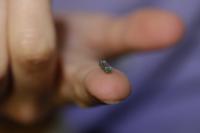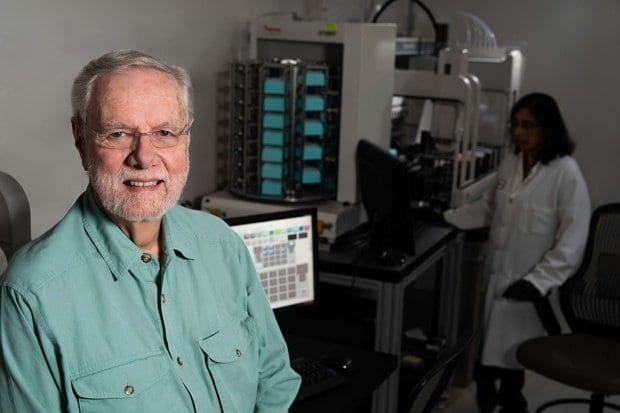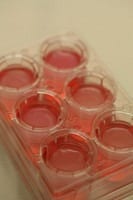
EPFL scientists have developed a tiny, portable personal blood testing laboratory that sends data through mobile phone network
Humans are veritable chemical factories – we manufacture thousands of substances and transport them, via our blood, throughout our bodies. Some of these substances can be used as indicators of our health status. A team of EPFL scientists has developed a tiny device that can analyze the concentration of these substances in the blood. Implanted just beneath the skin, it can detect up to five proteins and organic acids simultaneously, and then transmit the results directly to a doctor’s computer. This method will allow a much more personalized level of care than traditional blood tests can provide. Health care providers will be better able to monitor patients, particularly those with chronic illness or those undergoing chemotherapy. The prototype, still in the experimental stages, has demonstrated that it can reliably detect several commonly traced substances. The research results will be published and presented March 20, 2013 in Europe’s largest electronics conference, DATE 13.
Three cubic millimeters of technology
The device was developed by a team led by EPFL scientists Giovanni de Micheli and Sandro Carrara. The implant, a real gem of concentrated technology, is only a few cubic millimeters in volume but includes five sensors, a radio transmitter and a power delivery system. Outside the body, a battery patch provides 1/10 watt of power, through the patient’s skin – thus there’s no need to operate every time the battery needs changing.
Information is routed through a series of stages, from the patient’s body to the doctor’s computer screen. The implant emits radio waves over a safe frequency. The patch collects the data and transmits them via Bluetooth to a mobile phone, which then sends them to the doctor over the cellular network.
A system that can detect numerous substances
Great care was taken in developing the sensors. To capture the targeted substance in the body – such as lactate, glucose, or ATP – each sensor’s surface is covered with an enzyme. “Potentially, we could detect just about anything,” explains De Micheli. “But the enzymes have a limited lifespan, and we have to design them to last as long as possible.” The enzymes currently being tested are good for about a month and a half; that’s already long enough for many applications. “In addition, it’s very easy to remove and replace the implant, since it’s so small.”
The electronics were a considerable challenge as well. “It was not easy to get a system like this to work on just a tenth of a watt,” de Micheli explains. The researchers also struggled to design the minuscule electrical coil that receives the power from the patch.
Towards personalized chemotherapy
The implant could be particularly useful in chemotherapy applications. Currently, oncologists use occasional blood tests to evaluate their patients’ tolerance to a particular treatment dosage. In these conditions, it is very difficult to administer the optimal dose. De Micheli is convinced his system will be an important step towards better, more personalized medicine. “It will allow direct and continuous monitoring based on a patient’s individual tolerance, and not on age and weight charts or weekly blood tests.”
The Latest Bing News on:
Portable personal blood testing laboratory
- Doctors who treated patients with infected blood worked for firms making iton April 27, 2024 at 8:31 am
Doctors who treated patients with infected blood products worked for the companies who made them, The Telegraph can disclose.
- EU Commission Backs Thales-Led AI Project for Land Forces’ Optronic Systemson April 25, 2024 at 7:06 am
The European Commission has signed a Grant Agreement for the STORE (Shared daTabase for Optronics image Recognition and Evaluation) research proj ...
- Drake students participate in off-campus EMT programon April 24, 2024 at 6:05 pm
Every semester, Des Moines Area Community College offers the Emergency Medical Technician program on their Ankeny ...
- Best Weed Pens of 2024: 6 THC Dab Pens for Relaxationon April 24, 2024 at 3:32 pm
When testing, we liked that this pen allowed for greater dosage ... Designed for focus, energy, and motivation, these U.S.- grown, hemp-derived vape pens are lab-tested to help ensure a pure, potent ...
- Improved care after heart attack on AI-powered telemedicine platformon April 21, 2024 at 11:06 pm
Coronary artery disease (CAD) causes more than 1.8 million heart attacks each year in Europe, 300,000 in Germany alone. In most cases, rehabilitation helps the patients to return to their everyday ...
- Abbott Laboratories (NYSE:ABT) Q1 2024 Earnings Call Transcripton April 18, 2024 at 6:43 am
April 17, 2024 Abbott Laboratories isn't one of the 30 most popular stocks among hedge funds at the end of the third quarter (see the details here). Robert Ford - Chairman and Chief Executive Officer: ...
- Q1 2024 Abbott Laboratories Earnings Callon April 17, 2024 at 9:41 pm
Vijay Muniyappa Kumar; Senior MD and Head of Medical Supplies & Devices and Life Science Tools & Diagnostics Team; Evercore ISI Institutional Equities, Research Division ...
- Nightingale Health to Open US Lab, Provide Blood Testing Services to Weill Cornellon April 16, 2024 at 7:27 am
The firm said that the new laboratory will make its blood analysis technology available to the Englander Institute for Precision Medicine and other partners in the US.
- Breathalyzer Market Expands with Tech Advances and Stricter Alcohol Lawson April 16, 2024 at 7:01 am
Additionally, the rising use of alcohol and prevalence of alcohol-related crimes and abuses around the world led to more stringent legislation for the comprehensive testing of alcohol levels by ...
- Annual Blood Testing Clinic Set for Saturdayon April 15, 2024 at 8:59 pm
A blood testing clinic, sponsored by the Wapakoneta Rotary Club in cooperation with Lima Memorial Lab Services, is set for Saturday from 6:30-9:30 a.m. at the Grand Plaza Banquet Hall ...
The Latest Google Headlines on:
Portable personal blood testing laboratory
[google_news title=”” keyword=”portable personal blood testing laboratory” num_posts=”10″ blurb_length=”0″ show_thumb=”left”] [/vc_column_text]The Latest Bing News on:
Personalized blood tests
- Can Genetic Testing Reveal the Right Antidepressant?on April 27, 2024 at 6:23 am
Pharmacogenetic testing is also insightful about how non-pharmaceutical interventions, such as dietary supplements like l-methylfolate or magnesium, might benefit patients. The test even offers ...
- Digital Personalized Nutrition Market 2024 Exclusive Report with Accurate Forecast to 2031 | InsightAce Analyticon April 24, 2024 at 11:09 pm
The global digital personalized nutrition market is anticipated to have significant expansion in the coming years, propelled by technological progress. Biomarker analysis, microbiome analysis, and DNA ...
- Molecular You and Immunovia Announce Positive Results for Two Separate Pancreatic Cancer Testson April 23, 2024 at 3:00 am
This is just the latest advancement in detecting pancreatic cancer.
- Proactive health testing is the key to longevity and wellnesson April 22, 2024 at 9:56 am
Living a longer life has always been an aspiration for many, but longevity without health is a hollow victory. As Dr. Nathan Price, co-author of The Age of Scientific Wellness, points out, the focus ...
- Roche's Blood Test for Alzheimer's Earns FDA Breakthrough Device Designationon April 20, 2024 at 3:12 pm
Roche has announced that the FDA has awarded Breakthrough Device Designation to its Elecsys pTau217 blood test for the diagnosis of Alzheimer’s disease.
- Stanford’s Innovative Blood Test Offers New Hope for Hodgkin Lymphoma Patientson April 18, 2024 at 9:52 pm
Circulating tumor DNA predicts recurrence and splits disease into two subgroups in Stanford Medicine-led study of Hodgkin lymphoma. New drug targets or changes in treatments may reduce toxicity. A ...
- Vacuum Blood Collection Tube Market Growth Analysis, Size, Prominent Players, Overview, and Forecast to 2024 to 2032on April 16, 2024 at 4:51 pm
Report Ocean recently published a research report titled “Vacuum Blood Collection Tube Market” 2024 Forecast to 2032 Analysis by Market Trends.” This study delivers accurate economic projections, ...
- How AI can help cancer patients receive personalized and precise treatment fasteron April 16, 2024 at 1:35 pm
Providence and Microsoft are developing research prototype AI tools to sort through growing mountains of patient data.
- At-Home Molecular Testing Marketon April 15, 2024 at 9:14 pm
At-Home Molecular Testing Market is projected to reach US$ 18.1 billion by 2033, expanding at a healthy 5.9% CAGR.
- Gainful Offers Personalized Supplements to Help You Meet Your Goalson April 12, 2024 at 8:10 am
Gainful makes choosing supplements simple, thanks to customizable formulas and free guidance from registered dietitians.
The Latest Google Headlines on:
Personalized blood tests
[google_news title=”” keyword=”personalized blood tests” num_posts=”10″ blurb_length=”0″ show_thumb=”left”]










